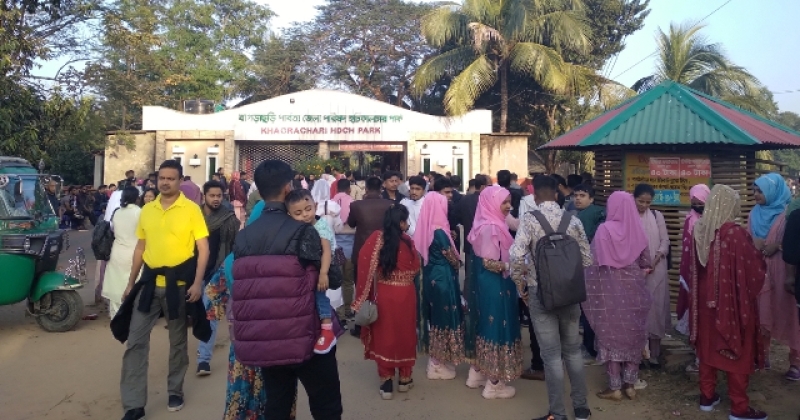- CA Yunus pays homage to Liberation War martyrs on Victory Day |
- Bangladesh capital market extends losing streak for second day |
- Bangladesh celebrates Victory Day Tuesday |
- 'Different govts presented history based on their own ideologies': JU VC |
Tourist surge brings fresh optimism to Khagrachhari businesses

The tourism industry in Khagrachhari is witnessing resurgence
Khagrachhari, Dec 15 - The tourism industry in Khagrachhari is witnessing resurgence as the flow of visitors to the hill district steadily increases following the lifting of a travel ban on November 5.
The ban, imposed on September 25 after violent incidents in Khagrachhari and Rangamati earlier that month, was expanded to encompass all three hill districts on October 8, leading to a complete pause in tourism.
The prolonged closure had a crippling impact on the local economy, particularly for those reliant on tourism.
Revival of Tourist Spots
As the law and order situation improves, tourist spots like Alutila Cave, Risang Waterfall and the Zila Parishad Park are regaining their vibrancy, attracting visitors from across the country.
Sajek Valley, a favourite among tourists, continues to see a steady influx of travellers.
Local business owners are optimistic about this resurgence.
Paritosh Tripura, who manages the Alutila Tourist Centre, noted a significant increase in ticket sales and anticipated even greater numbers as schools and colleges begin their year-end holidays in December.
Similarly, Khumali Tripura, a shopkeeper at the Zila Parishad Horticulture Park, expressed relief as business has picked up after a prolonged period of stagnation.
Shifting Tourist Patterns
While visitor numbers are rising, some business owners reported a shift in tourist activity.
Mohammad Rubel Parvez, owner of Montana Hotel and Restaurant, noted a slight decline in tourists compared to December last year.
He attributed this to more visitors heading directly to Dighinala rather than staying in Khagrachhari Sadar.
A manager at the ‘Aronyo Bilash’ hotel confirmed this trend, mentioning that bookings in Khagrachhari Sadar remain below last year’s levels.
Meanwhile, Mohammad Arif, who operates the Khagrachhari-Sajek ticket counter, said around 50–60 tourist vehicles travel daily between Khagrachhari and Sajek, with numbers spiking to 80–100 on weekends.
The Zila Parishad Horticulture Park, supervised by Thoaingongya Marma, currently hosts 400–500 visitors daily, with numbers doubling on holidays.
Renovation works are underway to further enhance the park’s appeal, including the addition of a children’s zone.
Unlocking Tourism Potential in CHT
The Chittagong Hill Tracts (CHT), encompassing Khagrachhari, Rangamati and Bandarban, hold immense potential as a premier tourist destination in Bangladesh.
Its unique natural beauty, cultural richness, and adventure tourism opportunities could significantly bolster the national tourism sector.
However, challenges persist.
Security concerns, inadequate infrastructure, and limited marketing efforts continue to hinder the region’s appeal, particularly to international travellers.
The government and local stakeholders emphasise the need for enhanced security, improved infrastructure, and targeted marketing initiatives to fully realise the potential of the region.
Broader Tourism Challenges in Bangladesh
Bangladesh’s tourism industry has faced multiple challenges in recent months. Political unrest and floods in August 2024 left hotels empty and resort bookings cancelled, exacerbating the sector's struggles.
The country ranks 109th out of 119 economies in the Travel & Tourism Development Index, the lowest among South Asian nations included in the ranking.
Despite these challenges, the government has prioritised tourism development. Its vision includes creating sub-regional zones, improving infrastructure, and implementing adequate regulations to attract more tourists.
Bangladesh’s tropical climate, historical landmarks and lush greenery continue to be major attractions.-UNB

